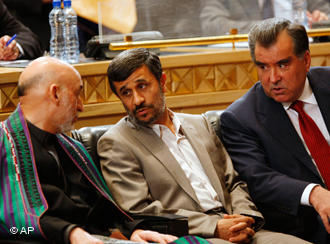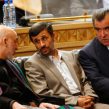
The “Persian Alliance” and Geopolitical Reconfiguration in Central Asia
Publication: Eurasia Daily Monitor Volume: 7 Issue: 161
By:

August 5 marked the fourth occasion in the last four years that the leaders of the Persian-speaking countries of Iran, Tajikistan, and Afghanistan convened, this time in Tehran, to chart the future of their trilateral cooperation. The meeting, dubbed the “Persian summit,” led to a series of agreements in the area of trade, energy, and transport, reaffirming their joint commitment to bolster regional security (www.rosbalt.ru, August 5).
Intensifying the level of such trilateral cooperation has raised speculation as to whether a “Persian alliance” may emerge with a potential to accelerate the geopolitical reconfiguration of Central Asia, which has been spurred by the collapse of the Soviet Union, 9/11, and the rise of China. The relative political and economic isolation of all three countries has been the driving force behind this expanding collaboration. Speaking at the summit, Iranian President, Mahmoud Ahmadinejad, proposed the creation of an organization in Asia similar to NATO after the withdrawal of coalition forces from the region. He also emphasized the importance of regional countries rebuilding Afghanistan, saying: “Others are unable to address this task. They could not deal with it in Iraq” (www.rbc.ru, August 6; www.centrasia.ru, August 7). Tehran, increasingly isolated and accused of pursuing a nuclear weapons program, feels encircled by US forces based in neighboring Iraq and Afghanistan.
In this context, and facing Turkey’s active foreign policy in the Middle East and beyond, Tehran has vigorously sought to expand ties with regional countries, primarily through transport and hydro-energy projects (www.cursorinfo.co.il, August 5; www.gazeta.tj, August 12; www.dw-world.de, May 12). These are the areas of collaboration that Dushanbe and Kabul can hardly ignore given their isolation from regional and global markets and security concerns associated with US plans for military disengagement.
Indeed, Tajikistan has actively sought to reduce its reliance on Uzbekistan as a transportation node and pursue southern transportation routes and electricity exports to end its energy and transport isolation. Yet, Tashkent’s opposition to the country’s hydro projects, capable of undermining Uzbekistan’s regional leverage, and alleged transportation blockades have hindered Tajikistan’s vision, despite Dushanbe’s related appeals to regional and international partners and organizations (www.warandpeace.ru, August 9; www.gazeta.tj, August 12; www.dw-world.de, June 10).
Tehran also threatened to block Uzbek rail cargo passing through Iran if Uzbekistan failed to lift the six month long blockade on freights to Sangtuda-2 hydro-station –Iran’s $180 million investment project in Tajikistan. In May, Tehran and Dushanbe signed a new defense treaty. Iran’s trade and investment in Tajikistan reached $250 and $650 million in 2009 and 2010, respectively. Both countries now stand to benefit from transport and energy projects that received a boost at the Persian summit and will help Tajikistan compete with Uzbekistan for international attention and markets in Afghanistan and South Asia (www.warandpeace.ru, August 9; www.dw-world.de, January 5, June 10).
Afghanistan will also benefit from such projects, as it has been cut off from its regional cultural zone for decades and currently faces the daunting challenges of war, reconstruction, and integration with the outside world. In Afghanistan, where Tajiks comprise about one third of the country’s predominantly Sunni Muslim population, the Karzai-led government, as in Iran, is not keen on seeing a comeback of the Wahhabi ideology-inspired Taliban (www.warandpeace.ru, August 9). Kabul further seeks to position itself as a transportation hub in the region, but faces significant connectivity constraints to fulfill this mission.
The projects discussed at the Persian summit, therefore, offer a development opportunity for Afghanistan, which is in need of energy imports and links with the outside world. Tajikistan, for instance, has an annual capacity to produce 527 billion kilowatts of electricity, yet it currently generates only 6 percent. Moreover, Afghan-Tajik economic and trade relations have increased almost twenty times over the last six years (www.ferghana.ru, August 6; www.avesta.tj, May 26; www.dw-world.de, August 7). During the summit, all parties also reaffirmed plans to build a joint railway network, ensure access to South Asia and regional sea ports, as well as enhance regional security.
While cooperation among the Persian-speaking countries (a total of more than 110 million people) offers numerous prospects, it can hardly grow into a political, let alone military alliance in the near future. Russia, the US and NATO countries, internal opposition in Tajikistan and Afghanistan, as well as the active relationships of these states with Russia and the US, are likely to limit its emergence (www.rbc.ru, August 6; www.dw-world.de, August 6 and 7; www.warandpeace.ru, August 9).
However, trilateral collaboration in the area of trade, energy, and transport will certainly facilitate geopolitical realignment in Central Asia –more so if China succeeds in extending its railway network across Kazakhstan to Tajikistan. During the Persian summit the parties stressed the need for five-sided meetings involving Iran, Afghanistan, Tajikistan, Kyrgyzstan, and China (www.vesti.kz, August 6).
Apparent isolation of all three Persian-speaking countries, with their similar and unique characteristics, is at the heart of their interest in expanding their trilateral relations. Such a partnership, while falling short of a political or military alliance in the near term, will enable Iran to increase its influence in Central Asia, especially given the already executed and planned military withdrawal by the US from Iraq and Afghanistan respectively. It will help both Tajikistan and Afghanistan strengthen their south-east and north-west vectors of relations with other countries. The growing cooperation equally has the potential to facilitate significant geopolitical reconfiguration in Central Asia. It will most likely promote the already ongoing reconnection of Central and South Asia, Afghanistan and the Middle East, leading to geopolitical contraction of some actors and expansion of others in the wider region.




